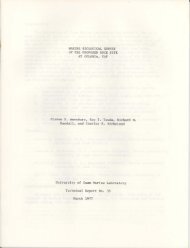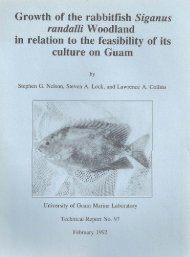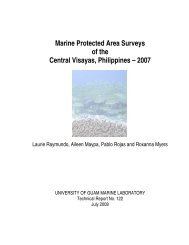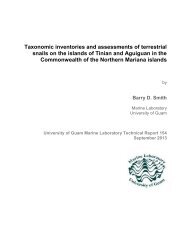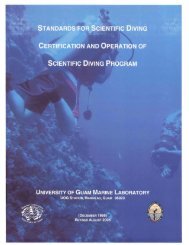survey of the shallow-water sea cucumbers of the central philippines
survey of the shallow-water sea cucumbers of the central philippines
survey of the shallow-water sea cucumbers of the central philippines
You also want an ePaper? Increase the reach of your titles
YUMPU automatically turns print PDFs into web optimized ePapers that Google loves.
Many <strong>of</strong> <strong>the</strong>se species were first described from <strong>the</strong> islands <strong>of</strong> <strong>the</strong><br />
<strong>central</strong> Philippines. These islands have long played an important part<br />
in our understanding <strong>of</strong> biological diversity, as <strong>the</strong>y are located close<br />
to <strong>the</strong> global epicentre <strong>of</strong> terrestrial and marine species richness. The<br />
islands’ rich flora and fauna were first documented in detail by<br />
several European scientists, notably Pr<strong>of</strong>. Carl Semper, who came to<br />
<strong>the</strong> islands in 1860. For over a year, Semper studied <strong>the</strong> butterflies,<br />
birds, fishes and marine invertebrates around <strong>the</strong> islands <strong>of</strong> Cebu and<br />
Bohol. Among his most important contributions to science, was his<br />
study <strong>of</strong> <strong>the</strong> islands’ <strong>sea</strong> <strong>cucumbers</strong> (Semper 1868). His exploration <strong>of</strong> <strong>the</strong> islands resulted in 41<br />
new species <strong>of</strong> holothuroids, which he described and illustrated in his publication Reisen im der<br />
Archipel Philippinen. To make his collections accessible to <strong>the</strong> scientific community, he placed<br />
his collections in various German museums. Unfortunately, <strong>the</strong>se museums suffered destruction<br />
during World War II, making many <strong>of</strong> his specimens unavailable for comparisons today.<br />
Methods<br />
The goal <strong>of</strong> this <strong>survey</strong> was to find as many <strong>of</strong> Semper’s species as possible and<br />
redescribe <strong>the</strong>m, as well as find previously undescribed species and make those available to <strong>the</strong><br />
global scientific community. From May 20 to June 18 2006, <strong>survey</strong>s were conducted at <strong>the</strong> reefs<br />
around <strong>the</strong> islands <strong>of</strong> Negros, Cebu, Bohol and neighboring localities. The team was able to find<br />
many specimens while snorkeling, but dives were also conducted both during <strong>the</strong> day and at<br />
night. The team took pictures <strong>of</strong> most <strong>of</strong> <strong>the</strong> species <strong>the</strong>y found and examined many pictures <strong>of</strong><br />
holothuroids from <strong>the</strong> region taken by previous re<strong>sea</strong>rchers/photographers. Several museum<br />
specimens were also examined to aid in identifications for this study. Table 1 provides a list <strong>of</strong><br />
all species and <strong>the</strong> locations at which <strong>the</strong>y were found. Because uncertainties still abound among<br />
scientists regarding <strong>the</strong> diagnoses <strong>of</strong> many holothuroid species, a few names in this list are still<br />
incomplete.<br />
2





